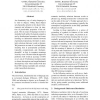Free Online Productivity Tools
i2Speak
i2Symbol
i2OCR
iTex2Img
iWeb2Print
iWeb2Shot
i2Type
iPdf2Split
iPdf2Merge
i2Bopomofo
i2Arabic
i2Style
i2Image
i2PDF
iLatex2Rtf
Sci2ools
ACL
2015
2015
Simple Learning and Compositional Application of Perceptually Grounded Word Meanings for Incremental Reference Resolution
An elementary way of using language is to refer to objects. Often, these objects are physically present in the shared environment and reference is done via mention of perceivable properties of the objects. This is a type of language use that is modelled well neither by logical semantics nor by distributional semantics, the former focusing on inferential relations between expressed propositions, the latter on similarity relations between words or phrases. We present an account of word and phrase meaning that is perceptually grounded, trainable, compositional, and ‘dialogueplausible’ in that it computes meanings word-by-word. We show that the approach performs well (with an accuracy of 65% on a 1-out-of-32 reference resolution task) on direct descriptions and target/landmark descriptions, even when trained with less than 800 training examples and automatically transcribed utterances.
| Added | 13 Apr 2016 |
| Updated | 13 Apr 2016 |
| Type | Journal |
| Year | 2015 |
| Where | ACL |
| Authors | Casey Kennington, David Schlangen |
Comments (0)

